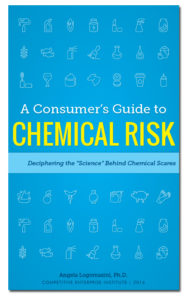Should you worry about “hazardous chemicals? They sure do sound scary! And environmental activists are aware of that, which is why they use the term regularly. Greenpeace claims: “Hazardous chemicals are substances that are dangerous to people, wildlife and the environment at any stage of their lifecycle, from production to use to disposal.”(1)
Green activist groups are working to phase out such hazardous products, and some have even assembled online databases that highlight the risks associated with certain chemicals that are considered “hazardous.” For example, the Environmental Working Group’s Skin Deep Database, which supposedly helps consumers understand the risks associated with chemicals used in cosmetics, is simply a mishmash of studies and other sources that report weak associations or suggestive findings, along with rodent studies of limited relevance to human exposures. They do not offer a sound scientific assessment of the body of research or weight of the evidence related to a chemical’s actual risk level.
Another coalition, SaferChemicals org, is pushing for the phase-out of 100 so-called hazardous products as part of its “Mind the Store” campaign. It notes on its website:
The Hazardous 100+ List of Chemicals of High Concern represents a small subset of all inherently hazardous chemicals of concern to which humans and the environment may be exposed in certain consumer products. Scientists have established links between exposures to many of these chemicals and chronic diseases and health conditions, including cancer, infertility, learning and developmental disabilities, behavioral problems, obesity, diabetes, and asthma.(2)
Here green groups condemn chemicals for their hazardous profiles and potential “links” to myriad health problems—no studies needed. They developed their list of 100 “hazardous” chemicals based on government “chemicals of concern” lists, which are developed not by comprehensive scientific risk review processes, but by politicians and regulators responding largely to media hype generated by environmental activists.
The lists include such substances as formaldehyde (which the human body itself produces through respiration), Bisphenol A, styrene, and more. All the chemicals listed are approved as safe at the trace levels found in consumer products by various government agencies around the globe. Many of these chemicals have been used for decades without any evidence of health related problems.
The focus on hazard rather than risk downplays, if not largely ignores, the benefits from these products. Hazard is the potential for harm at some level or under some specific circumstance. A risk assessment considers the probability that something will happen.
Consider the hazardous qualities associated with plain old water. It can kill you if you drink too much and experience “water intoxication,” which can swell your brain cells.(3) We all know that the risk of water intoxication is low from taking a few sips of water, but the risk level increases as an individual continues to consume the water at higher and higher levels. The hazard posed by the water remains the same in all instances while the risk changes with the exposure level.
Likewise, we have many “hazardous” chemicals in our homes—everything from cleaning supplies to bug spray to olive oil, which makes floors slippery when spilled. Each represents a hazard, but the risk depends on how we use them. Fortunately, we can benefit from each of these products while managing the risks to keep them low.
We all assess risks every day. We assess the risks of staying in bed versus the risks and benefits of getting up. We know the hazards associated with taking a shower, driving, and even eating (don’t forget the choking hazard). We manage these hazards by using a bathmat, driving carefully, and chewing our food well enough so that we can enjoy the benefits associated with swallowing it.
In the realm of public policy, “hazard assessment” is only one step in the risk assessment process whereby researchers consider risks associated with actual or estimated exposures. Yet thanks to environmental hype surrounding chemical hazards, current regulatory trends are moving toward using hazard as a justification for regulating or even banning the use of certain products, which would threaten our ability to enjoy the benefits of those products.
For example, the U.S. Environmental Protection Agency’s (EPA) Design for the Environment (DfE) program calls on companies to eliminate certain chemicals from their products voluntarily, largely on the basis of hazard rather than actual risk.(4) Similarly, the agency program to list chemicals on “concern lists” under the Toxic Substances Control Act embodies the idea that the use of certain “hazardous” chemicals is a problem regardless of the actual risk from exposure.(5) Many relatively safe and beneficial products may eventually disappear as a result.
Browse the terms on the sidebar of this webpage for more details and/or download a copy of A Consumer’s Guide to Chemical Risk: Deciphering the “Science” Behind Chemical Scares.
(1) “What are Hazardous Chemicals?” undated Greenpeace.org webpage.
(2) Safer Chemicals, Healthy Families, “What is the Hazardous 100+?”, accessed online October 24, 2013.
(3) D.J. Farrell and L. Bower, “Fatal Water Intoxication,”Journal of Clinical Pathology 56, no. 10 (October 2003): 803–804.
(4) “Design for the Environment,” EPA website, undated, accessed December 19, 2013.
(5) U.S. Environmental Protection Agency, “Essential Principles for Reform of Chemicals Management Legislation,” online document last updated April 28, 2010, accessed January 5, 2012.


